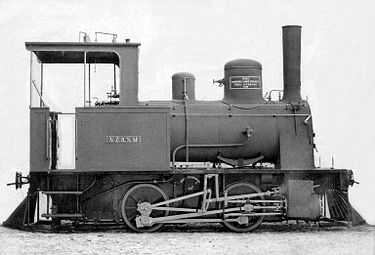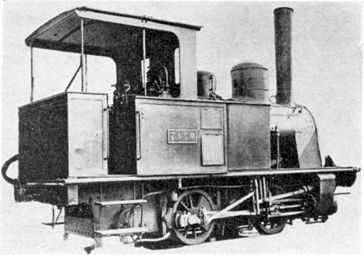NZASM 14 Tonner 0-4-0T
| NZASM 14 Tonner 0-4-0T | |
|---|---|
|
No. 1 "Transvaal", the first NZASM locomotive, preserved at the Outeniqua Transport Museum in George, 15 April 2013 | |
| Type and origin | |
| Power type | Steam |
| Designer | Maschinenfabrik Esslingen |
| Builder | Maschinenfabrik Esslingen |
| Serial number | 2317-2319, 2333-2334 |
| Build date | 1889 |
| Total produced | 5 |
| Specifications | |
| Configuration | 0-4-0T |
| Gauge | 3 ft 6 in (1,067 mm) Cape gauge |
| Driver diameter | 31 1⁄2 in (800 mm) |
| Wheelbase | 5 ft 3 in (1.600 m) |
| Length | 16 ft 10 7⁄8 in (5.153 m) over buffers |
| Height | 11 ft 2 in (3.404 m) |
| Axle load | 7 long tons (7.1 t) |
| Locomotive weight | 14 long tons (14 t) w/o |
| Fuel type | Coal |
| Fuel capacity | 0.35 long tons (0.36 t) |
| Water capacity | 300 imp gal (1,400 l; 360 US gal) |
| Boiler |
3 ft 1 5⁄16 in (0.948 m) inside diameter 6 ft 8 11⁄16 in (2.049 m) inside length 5 ft 4 1⁄2 in (1.638 m) pitch |
| Boiler pressure | 160 psi (1,100 kPa) |
| Firegrate area | 7.1 sq ft (0.660 m2) |
| Heating surface: – Tubes |
88 tubes of 1 3⁄4 in (44.4 mm) diameter 271 sq ft (25.177 m2) |
| – Firebox | 34 sq ft (3.159 m2) |
| – Total | 305 sq ft (28.335 m2) |
| Cylinders | Two |
| Cylinder size |
11 in (279 mm) bore 15 3⁄4 in (400 mm) stroke |
| Valve gear | Allen |
| Performance figures | |
| Tractive effort | 7,623 lbf (34 kN) at 75% pressure |
| Career | |
| Operator(s) |
NZASM Imperial Military Railways Central South African Railways |
| Class | NZASM 14 Tonner |
| Number in class | 5 |
| Number(s) | NZASM 1-5, IMR 601-605, CSAR A-D |
| Official name | 14 Tonner |
| Delivered | 1889 |
| First run | 1889 [1] |
| Preserved | 1 |
The NZASM 14 Tonner 0-4-0T of 1889 is a South African steam locomotive from the pre-Union era in the Transvaal.
In 1889 the Nederlandsche-Zuid-Afrikaansche Spoorweg-Maatschappij obtained its first five locomotives with a 0-4-0T wheel arrangement for use on the new line that was being constructed from Johannesburg to Boksburg. Since the railway classified its locomotives according to their weight, these side-tank locomotives were known as the 14 Tonners.[1]
The Randtram line
As a result of the rapid development of the goldfields on the Witwatersrand in the 1880s and the demand for coal by the growing industry, the Volksraad of the Zuid-Afrikaansche Republiek (ZAR), also known as the Transvaal Republic, granted a concession to the Nederlandsche-Zuid-Afrikaansche Spoorwegmaatschappij (Netherlands-South African Railway Company, NZASM) on 20 July 1888 to construct a 16 miles (26 kilometres) railway line from Johannesburg to Boksburg. The line, which was opened on 17 March 1890, became known as the "Randtram" line even though it was actually a railway in every aspect and not singularly dedicated to tram traffic. This was the first working railway line in the Transvaal.[1][2][3]
The concession was extended the following year to continue the line eastward to Springs, where coal was known to exist, and westward via Roodepoort to Krugersdorp. The entire 49 miles (79 kilometres) line was opened to traffic on 10 February 1891.[1]
Manufacturer
In 1889 five side-tank locomotives with a 0-4-0 wheel arrangement, the first locomotives of the NZASM and numbered in the range from 1 to 5, were obtained from the German engineering firm and locomotive builder Maschinenfabrik Esslingen, owned by Emil Kessler. Since the NZASM classified its locomotives according to their weight, these locomotives were known as 14 Tonners. They were erected at Elandslaagte near Johannesburg, now the city of Germiston, and were placed in service on the new line to Boksburg.[1]
Service
NZASM
As the Randtram line was expanded to the west and east to become the Reef line between Roodepoort and Springs, the 14 Tonners remained in service on that line even though their range of operation was somewhat limited by their small coal and water carrying capacities.[1] Photograpic evidence shows that the coal bunker and water tanks were enlarged at some stage after entering service.

The first locomotive, no. 1 named "Transvaal", entered service on 18 July 1889. It hauled the first train on the Randtram line when it was opened on 17 March 1890 and was retired in December 1903, by which time it had covered a distance of 113,309 miles (182,353 kilometres).[1]
Imperial Military Railways
All railway operations in the two Boer Republics, the ZAR and the Orange Free State, were taken over by the Imperial Military Railways (IMR) during the South African War. The IMR renumbering register made provision for all five 14 Tonners in the number range from 601 to 605, but it is not known whether all five were actually renumbered.[4]
Central South African Railways
At the end of the war, when the IMR was transformed into the Central South African Railways (CSAR), either three or four of the 14 Tonners survived and were renumbered, either from CSAR numbers A to C or from A to D. The uncertainty arises from the fact that the renumbering register lists CSAR number D both as NZASM 14 Tonner no. 5 and as one of the NZASM 18 Tonner locomotives.[4]
NZASM numbers 2, 3 and 5 were presumably allocated IMR numbers 602, 603 and 605 respectively, but apart from either IMR number 602 or 603 which presumably became CSAR number B, it is not known whether they actually were renumbered. All three of them were converted into stationary boilers at some stage. The gap in the CSAR renumbering (see table below) suggests that only one of NZASM numbers 2 and 3 survived into CSAR stock, presumably becoming CSAR number B.[4]
Preservation
Even though none of them were in service any longer when the South African Railways renumbering was carried out in 1912, the last of four of the 14 Tonners was only scrapped in 1916. NZASM no. 1, the engine Transvaal, was preserved and was declared a national monument by Government Notice no. 529 on 6 April 1936. It was plinthed on Pretoria station until the late 1960s when it was moved to the new Johannesburg station. It is now exhibited in the Outeniqua Transport Museum in George, Western Cape.[1][2]
Works numbers
The NZASM 14 Tonner works numbers, IMR and CSAR renumberings and their disposal are shown in the table.[1][4]
Loco no. |
Works no. |
IMR no. |
CSAR no. |
Stationary boiler no. |
|---|---|---|---|---|
| 1 | 2317 | 601 | A | |
| 2 | 2318 | 602? | B? | Boiler no. ? |
| 3 | 2319 | 603? | B? | Boiler no. 1585 |
| 4 | 2333 | 604 | C | |
| 5 | 2334 | 605? | D? | Boiler no. ? |
Modifications illustrated
Judging from the pictures below, it appears that the coal bunker and water tanks of the 14 Tonner were enlarged and the chimney was lengthened at some stage during its working life.[2]
-

14 Tonner, circa 1890, with a narrow coal bunker, small tanks and short chimney
-

14 Tonner, circa 1900, with a wider coal bunker, larger tanks and longer chimney
-
14 Tonner no. 1 at the Outeniqua Transport Museum, 15 April 2013
See also
- List of South African locomotive classes
- South African locomotive history
- The 0-4-0T wheel arrangement
References
|
- ↑ 1.0 1.1 1.2 1.3 1.4 1.5 1.6 1.7 1.8 Holland, D.F. (1971). Steam Locomotives of the South African Railways, Volume 1: 1859-1910 (1st ed.). Newton Abbott, Devon: David & Charles. pp. 109–110. ISBN 978-0-7153-5382-0.
- ↑ 2.0 2.1 2.2 The South African Railways - Historical Survey. Editor George Hart, Publisher Bill Hart, Sponsored by Dorbyl Ltd., Published c. 1978, p. 19.
- ↑ A South African Railway History
- ↑ 4.0 4.1 4.2 4.3 Information supplied by John Nicholas Middleton
_IMR-CSAR_438.jpg)
